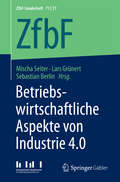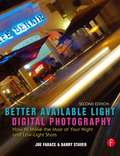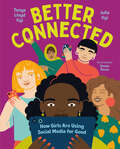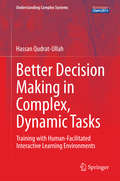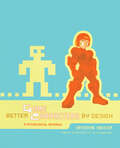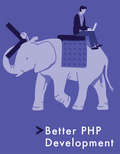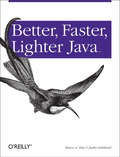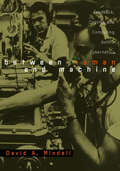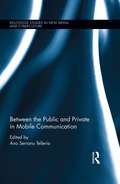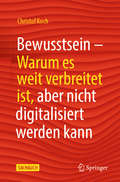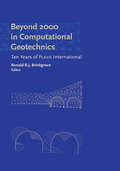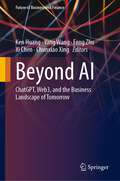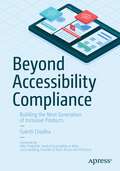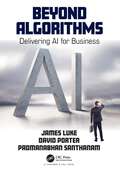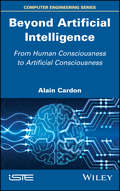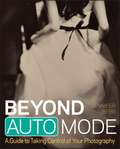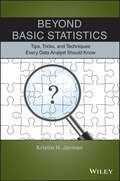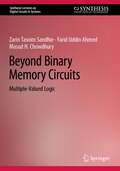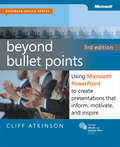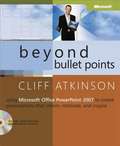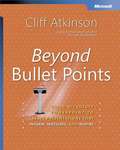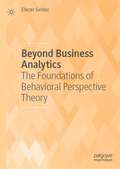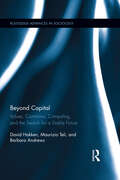- Table View
- List View
Betriebswirtschaftliche Aspekte von Industrie 4.0 (ZfbF-Sonderheft #71/17)
by Mischa Seiter Lars Grünert Sebastian BerlinDas Sonderheft der ZfbF stellt die Ergebnisse des Arbeitskreises "Integrationsmanagement neuer Produkte" der Schmalenbach-Gesellschaft dar und zeigt facettenreich auf, wie umfassend die betriebswirtschaftliche Forschung bei der L#65533;sung der aufkommenden unternehmerischen Fragestellungen durch Industrie 4. 0 mitwirken kann. Industrie 4. 0 besch#65533;ftigt seit einigen Jahren die deutschen Unternehmen als eines von zehn Zukunftsprojekten der Bundesregierung. Die Untersuchung der betriebswirtschaftlichen Auswirkungen dieser Entwicklungen bildete, bis auf wenige Ausnahmen, einen Randaspekt der Forschung. Allerdings verursachten Industrie 4. 0-Initiativen in den letzten Jahren bereits weitreichende betriebswirtschaftliche Konsequenzen, die zum Teil ganze Branchen ver#65533;nderten. Wortmann, Bilgeri, Weinberger und Fleisch beleuchten die Entwicklung von Ertragsmodellen im Internet of Things. Die Autoren Gr#65533;nert und Sejdic leiten zun#65533;chst einen Bezugsrahmen f#65533;r Industrie 4. 0-getriebene Gesch#65533;ftsmodellinnovation ab. Kersten, Schr#65533;der und Indorf analysieren die Auswirkungen der Digitalisierung auf das Supply Chain Risikomanagement. Butschan, Nestle, Munck und Gleich befassen sich mit dem Kompetenzaufbau zur Umsetzung von Industrie 4. 0 in der Produktion. Schlie#65533;lich arbeiten Obermaier und Grottke die Herausforderungen von ,,Industrie 4. 0"-Technologien f#65533;r das Controlling heraus und zeigen das Potential dieser Technologien f#65533;r das Controlling auf.
Betriebswirtschaftliche KI-Anwendungen: Digitale Geschäftsmodelle auf Basis Künstlicher Intelligenz
by Christian Aichele Jörg HerrmannDigitalisierung und Künstliche Intelligenz ermöglichen Unternehmen disruptive Erweiterungen ihrer Geschäftsmodelle. Wer rechtzeitig digitale KI-Geschäftsmodelle einführt, wird seinen Erfolg nachhaltig sichern können. Aber wie und wo können solche Modelle Anwendung finden? Diese Publikation gibt Antworten, wo KI-Geschäftsmodelle greifen können, und wie diese von der ersten Idee bis zur produktiven Anwendung realisiert werden können.
Betriebswirtschaftliche KI-Anwendungen: Digitale Geschäftsmodelle auf Basis Künstlicher Intelligenz
by Christian Aichele Jörg HerrmannDigitalisierung und Künstliche Intelligenz ermöglichen Unternehmen disruptive Erweiterungen ihrer Geschäftsmodelle. Wer rechtzeitig digitale KI-Geschäftsmodelle einführt, wird seinen Erfolg nachhaltig sichern können. Aber wie und wo können solche Modelle Anwendung finden? Diese Publikation gibt Antworten, wo KI-Geschäftsmodelle greifen können, und wie diese von der ersten Idee bis zur produktiven Anwendung realisiert werden können.
Better Available Light Digital Photography: How to Make the Most of Your Night and Low-Light Shots
by Joe Farace Barry StaverThis classic book on available light photography is back, thoroughly updated for digital photography and, for the first time, is packed with stunning, full color images throughout. Creating great images under less-than-ideal lighting conditions is one of the most difficult, yet rewarding, experiences in photography. Challenge yourself, and with this book by your side you won't be disappointed. Photography expert Joe Farace and Pulitzer Prize winner Barry Staver use real-world examples of their own images to give you invaluable advice on how to get the shot right the first time. From practical tips, such as how to deal with inclement weather while shooting outdoors, to detailed information about getting great shots at your cousin's or your client's wedding, to brand new chapters on noise and white balance, you'll find everything that you need to turn your ordinary night and low-light shots into masterful works of art.
Better Connected: How Girls Are Using Social Media for Good (Orca Think #5)
by Tanya Lloyd Kyi Julia KyiThe online world has real dangers, but girls around the world are using social media to create positive change and practice good digital citizenship. You've probably seen media stories about the ways girls interact online, with headlines like "Depression in Girls Linked to Higher Use of Social Media," or "Half of Girls Are Bullied on Social Media." Better Connected focuses on the less-recognized and positive aspects of the online experiences of girls. From environmental activism to gun control, immigration policy to education access, girls are leading the way. They're showing up, teaming up and speaking up. With profiles of real changemakers and practical tools for getting started, Better Connected is an inspiring look at the amazing things girls can accomplish online.
Better Decision Making in Complex, Dynamic Tasks: Training with Human-Facilitated Interactive Learning Environments (Understanding Complex Systems)
by Hassan Qudrat-UllahComputer simulation-based education and training is a multi-billion dollar industry. With the increased complexity of organizational decision making, projected demand for computer simulation-based decisional aids is on the rise. The objective of this book is to enhance systematically our understanding of and gain insights into the general process by which human facilitated ILEs are effectively designed and used in improving users' decision making in dynamic tasks. This book is divided into four major parts. Part I serves as an introduction to the subject of "decision making in dynamic tasks", its importance and its complexity. Part II provides background material, drawing upon the relevant literature, for the development of an integrated process model on the effectiveness of human facilitated ILEs in improving decision making in dynamic tasks. Part III focuses on the design, development and application of Fish Bank ILE, in laboratory experiments, to gather empirical evidence for the validity of the process model. Finally, part IV presents a comprehensive analysis of the gathered data to provide a powerful basis for understating important phenomena of training with human facilitated simulation-based learning environments, thereby, help to drive critical lessons to be learned. This book provides the reader with both a comprehensive understanding of the phenomena encountered in decision making with human facilitated ILEs and a unique way of studying the effects of these phenomena on people's ability to make better decision in complex, dynamic tasks. This book is intended to be of use to managers and practitioners, researchers and students of dynamic decision making. The background material of Part II provides a solid base to understand and organize the existing experimental research literature and approaches.
Better Game Characters by Design: A Psychological Approach
by Katherine IsbisterGames are poised for a major evolution, driven by growth in technical sophistication and audience reach. Characters that create powerful social and emotional connections with players throughout the game-play itself (not just in cut scenes) will be essential to next-generation games. However, the principles of sophisticated character design and interaction are not widely understood within the game development community. Further complicating the situation are powerful gender and cultural issues that can influence perception of characters. Katherine Isbister has spent the last 10 years examining what makes interactions with computer characters useful and engaging to different audiences. This work has revealed that the key to good design is leveraging player psychology: understanding what's memorable, exciting, and useful to a person about real-life social interactions, and applying those insights to character design. Game designers who create great characters often make use of these psychological principles without realizing it. Better Game Characters by Design gives game design professionals and other interactive media designers a framework for understanding how social roles and perceptions affect players' reactions to characters, helping produce stronger designs and better results.
Better PHP Development
by Christopher Pitt Bruno Skvorc Thomas Punt Younes Rafie Reza LavaryanPHP powers the vast majority of the web today. It is by far the most ubiquitous and accessible mature web language, and welcomes thousands of new developers every day. It is this ease of access that can, admittedly, sometimes give it a bad name - good resources are few and far in between, and the competition is real, driving people to take shortcuts, skip best practices, and learn on-the-fly. With PHP 7+ came some improvements that make it harder to make mistakes, and 7.2 is making things even safer, even more structured. If you're just getting started with the language (or perhaps youve been using it a while and have learned some bad habits), you're in luck. Not only will it be ever harder to slip up and make mistakes, but content such as this - hand picked from the excellent SitePoint PHP channel - will help you get started the right way. This collection comprises: How PHP Executes - from Source Code to Render by Thomas PuntGetting to Know and Love Xdebug by Bruno Ã…Â kvorcLocalization Demystified: Php-Intl for Everyone by Younes RafieEvent Sourcing in a Pinch by Christopher PittDisco with Design Patterns: A Fresh Look at Dependency Injection by Reza LavaryanA Comprehensive Guide to Using Cronjobs by Reza LavaryanEvent Loops in PHP by Christopher PittPDO - the Right Way to Access Databases in PHP by Parham DoustdarVagrant: The Right Way to Start with PHP by Bruno Ã…Â kvorc This book is suitable for beginner- to intermediate-level PHP developers.
Better, Faster, Lighter Java
by Justin Gehtland Bruce TateSometimes the simplest answer is the best. Many Enterprise Java developers, accustomed to dealing with Java's spiraling complexity, have fallen into the habit of choosing overly complicated solutions to problems when simpler options are available. Building server applications with "heavyweight" Java-based architectures, such as WebLogic, JBoss, and WebSphere, can be costly and cumbersome. When you've reached the point where you spend more time writing code to support your chosen framework than to solve your actual problems, it's time to think in terms of simplicity.In Better, Faster, Lighter Java, authors Bruce Tate and Justin Gehtland argue that the old heavyweight architectures are unwieldy, complicated, and contribute to slow and buggy application code. As an alternative means for building better applications, the authors present two "lightweight" open source architectures: Hibernate--a persistence framework that does its job with a minimal API and gets out of the way, and Spring--a container that's not invasive, heavy or complicated.Hibernate and Spring are designed to be fairly simple to learn and use, and place reasonable demands on system resources. Better, Faster, Lighter Java shows you how they can help you create enterprise applications that are easier to maintain, write, and debug, and are ultimately much faster.Written for intermediate to advanced Java developers, Better, Faster, Lighter Java, offers fresh ideas--often unorthodox--to help you rethink the way you work, and techniques and principles you'll use to build simpler applications. You'll learn to spend more time on what's important. When you're finished with this book, you'll find that your Java is better, faster, and lighter than ever before.
Between Human and Machine: Feedback, Control, and Computing before Cybernetics (Johns Hopkins Studies in the History of Technology)
by David A. MindellToday, we associate the relationship between feedback, control, and computing with Norbert Wiener's 1948 formulation of cybernetics. But the theoretical and practical foundations for cybernetics, control engineering, and digital computing were laid earlier, between the two world wars. In Between Human and Machine: Feedback, Control, and Computing before Cybernetics, David A. Mindell shows how the modern sciences of systems emerged from disparate engineering cultures and their convergence during World War II. Mindell examines four different arenas of control systems research in the United States between the world wars: naval fire control, the Sperry Gyroscope Company, the Bell Telephone Laboratories, and Vannevar Bush's laboratory at MIT. Each of these institutional sites had unique technical problems, organizational imperatives, and working environments, and each fostered a distinct engineering culture. Each also developed technologies to represent the world in a machine.At the beginning of World War II, President Roosevelt established the National Defense Research Committee, one division of which was devoted to control systems. Mindell shows how the NDRC brought together representatives from the four pre-war engineering cultures, and how its projects synthesized conceptions of control, communications, and computing. By the time Wiener articulated his vision, these ideas were already suffusing through engineering. They would profoundly influence the digital world. As a new way to conceptualize the history of computing, this book will be of great interest to historians of science, technology, and culture, as well as computer scientists and theorists. Between Human and Machine: Feedback, Control, and Computing before Cybernetics
Between the Public and Private in Mobile Communication (Routledge Studies in New Media and Cyberculture)
by Ana Serrano TelleríaMobile devices’ impact on daily life has raised relevant questions regarding public and private space and communication. Both the technological environment (operating systems, platforms, apps) and media ecosystems (interface design, participatory culture, social media) influence how users deal with the public and private, intimate and personal spheres. Leading researchers in communication, art, computer engineering, education, law, sociology, philosophy, and psychology here explore current methodologies for studying the dichotomy of the public and private in mobile communication, providing a foundation for further research.
Bewusstsein: Warum es weit verbreitet ist, aber nicht digitalisiert werden kann
by Christof KochBewusstsein – das weiter verbreitet ist als bisher angenommen – ist das Gefühl, lebendig zu sein, es ist kein Rechenvorgang und auch kein cleverer Trick. In diesem Buch liefert Christof Koch eine schnörkellose Definition des Bewusstseins als bewusstes Erleben, vom alltäglichsten bis zum außergewöhnlichsten – eben das Gefühl zu leben.Die Psychologie erforscht, welche kognitiven Vorgänge einer bewussten Wahrnehmung jeweils zugrunde liegen. Die Neurowissenschaft spürt den neuronalen Korrelaten des Bewusstseins im Gehirn nach, dem Organ des Geistes. Aber warum das Gehirn und nicht etwa die Leber oder ein anderes Organ? Wie kann das Gehirn, drei Pfund höchst erregbares Gewebe, ein Gegenstand im Universum, der denselben physikalischen Gesetzen gehorcht wie jeder andere Gegenstand, subjektives Erleben hervorbringen? Will man eine Antwort auf diese Frage finden, braucht man, so Koch, eine quantitative Theorie, die beim Erleben ansetzt und zum Gehirn fortschreitet. Im vorliegenden Buch umreißt der Autor eine solche Theorie, basierend auf der integrierten Informationstheorie. Koch beschreibt, wie die Theorie viele Fakten zur Neurologie des Bewusstseins erklärt und wie man mit ihrer Hilfe sogar ein in der Klinik einsetzbares Bewusstseins-Messgerät konstruiert hat. Die Theorie sagt voraus, dass viele, ja vielleicht alle Tiere das Leben in vielen Facetten erleben; Bewusstsein ist viel weiter verbreitet als allgemein angenommen. Entgegen der landläufigen Ansicht aber argumentiert Koch, dass programmierbare Computer kein Bewusstsein haben werden. Selbst ein perfektes Softwaremodell des Gehirns ist nicht bewusst – es simuliert lediglich Bewusstsein. Bewusstsein ist keine bestimmte Art von Rechenvorgang, es ist kein cleverer Trick. Bewusstsein ist Sein.reich mit dem Sachbuchprogramm waren.
Beyond 2000 in Computational Geotechnics
by Ronald B.J. BrinkgreveThis volume contains papers presented during the first international PLAXIS symposium. Topics covered include: general geo-technical aspects; tunnels and deep excavations, and education and research. This pack is meant for the user of the PLAXIS program, as well as engineers and researchers.
Beyond AI: ChatGPT, Web3, and the Business Landscape of Tomorrow (Future of Business and Finance)
by Xi Chen Feng Zhu Yang Wang Chunxiao Xing Ken HuangThis book explores the transformative potential of ChatGPT, Web3, and their impact on productivity and various industries. It delves into Generative AI (GenAI) and its representative platform ChatGPT, their synergy with Web3, and how they can revolutionize business operations. It covers the potential impact surpassing prior industrial revolutions.After providing an overview of GenAI, ChatGPT, and Web3, it investigates business applications in various industries and areas, such as product management, finance, real estate, gaming, and government, highlighting value creation and operational revolution through their integration. It also explores their impact on content generation, customer service, personalization, and data analysis and examines how the technologies can enhance content quality, customer experiences, sales, revenue, and resource efficiency. Moreover, it addresses security, privacy, and ethics concerns, emphasizing the responsible implementation of ChatGPT and Web3. Written by experts in this field, this book is aimed at business leaders, entrepreneurs, students, investors, and professionals who are seeking insights into ChatGPT, ChatGPT Plug-in, GPT-based autonomous agents, and the integration of Gen AI and Web3 in business applications.
Beyond Accessibility Compliance: Building the Next Generation of Inclusive Products
by Sukriti ChadhaTake a deep look at accessibility as it applies to mobile and wearables. This book covers topics within the accessibility domain that are rarely covered or understood, despite the fact that nearly half of the world’s population uses smartphones. Moreover, by 2025, 72% of smartphone users are expected to only use smartphones to access the internet. And yet, accessibility is often an afterthought instead of a core principle of product development. This book changes that.You will begin by exploring the current landscape and policy frameworks, looking at the software product lifecycle and how to embed inclusion from the start. You’ll learn the nuances of mobile accessibility as it applies to mobile devices, wearables, and IoT. From there you’ll move onto automated testing, accessibility and inclusion, and the next frontiers of emerging technology including AR and VR. There will be notes at the end of programming examples to help those in orthogonal roles, such as project management, understand the basics and the language to better communicate with their engineering counterparts. Over 1 billion people in the world live with some form of disability so it's imperative you devise a comprehensive game plan to make your digital products accessible for all. Beyond Accessibility Compliance is your guide to understanding the current landscape of assistive technology and how emerging techniques are changing the way we think about personalization and accessibility.What You'll Learn See how people with the most common forms of disabilities use digital productsReview the basics of the product development lifecycle and how to embed accessibility Explore tangible answers as to how accessibility pertains to unique rolesUnderstand the difference between compliance and usabilityMake data visualizations accessible for blind usersImplement code-level changes to address gaps in accessibility Build a campus programs and course material inclusive for people with disabilities Who This Book Is For Current developers, designers, and others building technology products with basic knowledge of front-end development. This book is also suitable for students in computer science, engineering, HCI, and related fields. Sections that are not engineering-specific are applicable to design, user research, communication, and business students who are looking to pursue careers in technology.
Beyond Algorithms: Delivering AI for Business
by David Porter James Luke Padmanabhan SanthanamWith so much artificial intelligence (AI) in the headlines, it is no surprise that businesses are scrambling to exploit this exciting and transformative technology. Clearly, those who are the first to deliver business-relevant AI will gain significant advantage. However, there is a problem! Our perception of AI success in society is primarily based on our experiences with consumer applications from the big web companies. The adoption of AI in the enterprise has been slow due to various challenges. Business applications address far more complex problems and the data needed to address them is less plentiful. There is also the critical need for alignment of AI with relevant business processes. In addition, the use of AI requires new engineering practices for application maintenance and trust. So, how do you deliver working AI applications in the enterprise? Beyond Algorithms: Delivering AI for Business answers this question. Written by three engineers with decades of experience in AI (and all the scars that come with that), this book explains what it takes to define, manage, engineer, and deliver end-to-end AI applications that work. This book presents Core conceptual differences between AI and traditional business applications A new methodology that helps to prioritise AI projects and manage risks Practical case studies and examples with a focus on business impact and solution delivery Technical Deep Dives and Thought Experiments designed to challenge your brain and destroy your weekends
Beyond Artificial Intelligence: From Human Consciousness to Artificial Consciousness
by Alain CardonThis book will present a complete modeling of the human psychic system that allows to generate the thoughts in a strictly organizational approach that mixes a rising and falling approach. The model will present the architecture of the psychic system that can generate sensations and thoughts, showing how one can feel thoughts. The model developed into an organizational architecture based on massive multiagent systems. The architecture will be fully developed, showing how an artificial system can be endowed with consciousness and intentionally generate thoughts and, especially, feel them. These results are multidisciplinary, combining both psychology and computer science disciplines.
Beyond Auto Mode
by Jennifer BebbTake full advantage of your dSLR camera, and do it with confidenceMany people buy dSLR cameras for their flexibility, but find themselves so intimidated by all the options and controls that they rarely venture beyond the automatic mode. With a friendly tone and clear, understandable instruction, photographer and educator Jen Bebb introduces you to every mode and setting on your sophisticated dSLR. After thoroughly explaining shutter speed, aperture, depth of field, ISO, and basic composition, she offers direction on what each camera mode does and when it should be used. You'll gain the confidence to use the entire feature set you paid for.Beginning dSLR users are often intimidated by the scene, semi-automatic, and fully manual modes on their cameras; this guide gently explains each mode and settingUses a conversational tone and liberal examples to define and explain basic concepts including shutter speed, aperture, ISO, depth of field, and compositionCovers how each camera mode works and when to consider using itHelps those new to dSLR photography to gain confidence and begin taking advantage of all the flexibility a dSLR offersWritten by a professional photographer who is also known for her skill as an instructor, Beyond Auto Mode encourages new and less experienced dSLR users to take the next step toward creative control.
Beyond Basic Statistics
by Kristin H. JarmanFeatures basic statistical concepts as a tool for thinking critically, wading through large quantities of information, and answering practical, everyday questions Written in an engaging and inviting manner, Beyond Basic Statistics: Tips, Tricks, and Techniques Every Data Analyst Should Know presents the more subjective side of statistics--the art of data analytics. Each chapter explores a different question using fun, common sense examples that illustrate the concepts, methods, and applications of statistical techniques. Without going into the specifics of theorems, propositions, or formulas, the book effectively demonstrates statistics as a useful problem-solving tool. In addition, the author demonstrates how statistics is a tool for thinking critically, wading through large volumes of information, and answering life's important questions. Beyond Basic Statistics: Tips, Tricks, and Techniques Every Data Analyst Should Know also features: Plentiful examples throughout aimed to strengthen readers' understanding of the statistical concepts and methods A step-by-step approach to elementary statistical topics such as sampling, hypothesis tests, outlier detection, normality tests, robust statistics, and multiple regression A case study in each chapter that illustrates the use of the presented techniques Highlights of well-known shortcomings that can lead to false conclusions An introduction to advanced techniques such as validation and bootstrapping Featuring examples that are engaging and non-application specific, the book appeals to a broad audience of students and professionals alike, specifically students of undergraduate statistics, managers, medical professionals, and anyone who has to make decisions based on raw data or compiled results.
Beyond Binary Memory Circuits: Multiple-Valued Logic (Synthesis Lectures on Digital Circuits & Systems)
by Masud H. Chowdhury Zarin Tasnim Sandhie Farid Uddin AhmedThis book provides readers with an overview of the fundamental definitions and features of Multiple-Valued Logic (MVL). The authors include a brief discussion of the historical development of MVL technologies, while the main goal of the book is to present a comprehensive review of different technologies that are being explored to implement multiple-valued or beyond-binary memory circuits and systems. The discussion includes the basic features, prospects, and challenges of each technology, while highlighting the significant works done on different branches of MVL memory architecture, such as sequential circuits, random access memory, Flash memory, etc.
Beyond Bullet Points
by Cliff AtkinsonUnlock the amazing story buried in your presentation--and forget boring, bullet-point-riddled slides forever! Guided by communications expert Cliff Atkinson, you'll walk you through an innovative, three-step methodology for increasing the impact of your presentation. Discover how to combine classic storytelling techniques with the power of visual media to create a rich, engaging experience with your audience. Fully updated for PowerPoint 2010, and featuring compelling presentation examples from classroom to boardroom, this book will help transform your presentations--and your business impact!
Beyond Bullet Points: Using Microsoft® Office PowerPoint® 2007 to Create Presentations That Inform, Motivate, and Inspire
by Cliff AtkinsonUnlock the amazing story buried in your presentation--and forget boring bullet points forever! Now updated for Microsoft Office PowerPoint 2007, this widely-acclaimed book includes seven new examples of compelling presentations from board room to classroom. Communications expert Cliff Atkinson guides you, step by step, through his revolutionary three-step method for increasing the impact of your presentations. You'll discover how to combine classic storytelling techniques with the power of visual media to create a rich, engaging experience. Transform the way you create and deliver your critical message--and quickly bring your ideas to life! FOCUS: Learn how to distill and shape your best ideas into a crisp and compelling narrative. CLARIFY: Use a storyboard to illustrate your ideas, creating the right blend of message and media. ENGAGE: Move from merely reading your slides to creating a rich, connected experience with your audience--and increase your impact! CD includes: Cliff's custom templates--build your story! Quick reference checklists for compelling presentations Complete eBook--plus bonus content! A Note Regarding the CD or DVD The print version of this book ships with a CD or DVD. For those customers purchasing one of the digital formats in which this book is available, we are pleased to offer the CD/DVD content as a free download via O'Reilly Media's Digital Distribution services. To download this content, please visit O'Reilly's web site, search for the title of this book to find its catalog page, and click on the link below the cover image (Examples, Companion Content, or Practice Files). Note that while we provide as much of the media content as we are able via free download, we are sometimes limited by licensing restrictions. Please direct any questions or concerns to booktech@oreilly.com.
Beyond Bullet Points: Using Microsoft® PowerPoint® to Create Presentations That Inform, Motivate, and Inspire
by Cliff AtkinsonUnload those boring, bullet-riddled slides--and unlock the amazing story buried in your presentation! In BEYOND BULLET POINTS, communications expert Cliff Atkinson shares his innovative three-step system for increasing the impact of your communications with Microsoft PowerPoint. He guides you, step by step, as you discover how to combine the tenets of classic storytelling with the power of the projected media to create a rich, engaging experience. He walks you through his easy-to-use templates, plus 50 advanced tips, to help build your confidence and effectiveness--and quickly bring your ideas to life! FOCUS: Learn how to distill your best ideas into a crisp and compelling narrative. CLARIFY: Use a storyboard to clarify and visualize your ideas, creating the right blend of message and media. ENGAGE:Move from merely reading your slides to creating a rich, connected experience with your audience--and increase your impact! Inside!: See sample storyboards for a variety of presentation types--including investment, sales, educational, and training.
Beyond Business Analytics: The Foundations of Behavioral Perspective Theory
by Eliezer GeislerThis book explores the role that data analysis plays in the managerial decision-making process. The author presents the notion of "beyond analytics," which proposes that through data collection managers evaluate patterns in business processes through models of cognitive representation, framing and modeling, and knowledge creation in businesses. The book focuses on how the massive amounts of business data can be reduced to manageable volumes, thus allowing managers to make informed decisions. Further, it relates beyond analytics to HR aspects of the business and succession planning. This book will inform organizational behavioral theorists how the management of data impacts the decision-making process in organizations.
Beyond Capital: Values, Commons, Computing, and the Search for a Viable Future (Routledge Advances in Sociology #168)
by Barbara Andrews David Hakken Maurizio TeliThe financial/social cataclysm beginning in 2007 ended notions of a “great moderation” and the view that capitalism had overcome its systemic tendencies to crisis. The subsequent failure of contemporary social formations to address the causes of the crisis gives renewed impetus to better analysis in aid of the search for a better future. This book contributes to this search by reviving a broad discussion of what we humans might want a post-capitalist future to be like. It argues for a comparative anthropological critique of capital notions of value, thereby initiating the search for a new set of values, as well as identifying a number of selected computing practices that might evoke new values. It articulates a suggestive set of institutions that could support these new values, and formulates a group of measurement practices usable for evaluating the proposed institutions. The book is grounded in contemporary social science, political theory, and critical theory. It aims to leverage the possibility of alternative futures implied by some computing practices while avoiding hype and technological determinism, and uses these computing practices to explicate one possible way to think about the future.
